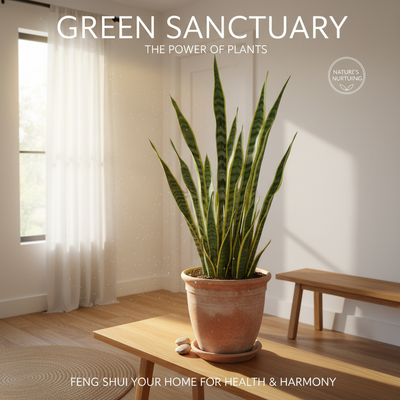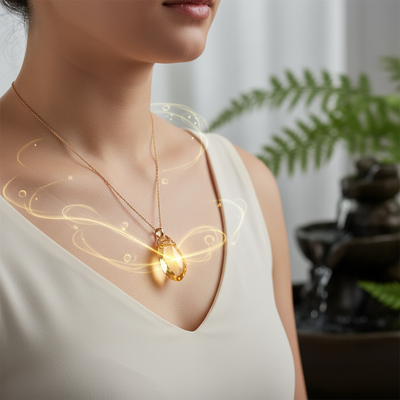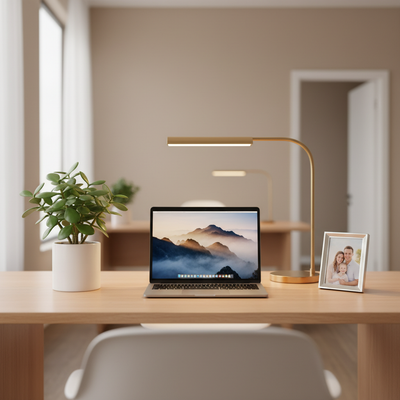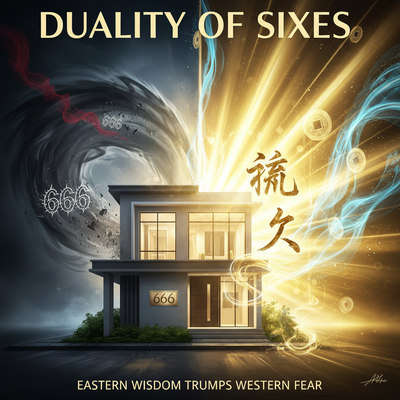Introduction

Do you ever feel stuck, unfocused, or simply uninspired at your desk? You have the skills and the drive, but something feels wrong. Your workspace, the very place meant for getting things done, might be quietly working against you. This is a common problem for working people, business owners, and students alike, but there is a powerful and ancient solution.
This guide will show you how to choose the perfect feng shui desk color to transform your workspace into a center of productivity, opportunity, and success. The main idea of Feng Shui is that your surroundings deeply affect your energy. By making a thoughtful choice about something as simple as your desk color, you can actively shape the energy around you to boost creativity, improve focus, and attract opportunities.
The first question is often, "What is the best feng shui desk color?" The truth is, there is no single "best" color for everyone. The ideal color depends entirely on your personal goals, your work field, and even your unique energy makeup. This guide will give you the clear, practical steps to discover the perfect color for you.
Why Desk Color Matters
To make a smart choice, it's important to understand the basic principles at work. Choosing a feng shui desk color isn't about superstition; it's about using color as a tool to influence the energy, or Qi, in your environment. This creates a space that actively supports your goals, rather than just holding your laptop.
Understanding Qi Energy
At the heart of Feng Shui is the concept of Qi (pronounced "chee"), which means "life force energy." Qi is the unseen energy that flows through everything in the universe, including you and your workspace. Think of the Qi in your office like a river. When it flows smoothly and gently, it brings nourishment, vitality, and opportunity.
However, if the flow is blocked, the energy becomes stagnant, leading to feelings of being stuck, tired, or uninspired. If the flow is too fast or chaotic, it can create stress, anxiety, and a feeling of being overwhelmed. Objects, their placement, their materials, and especially their colors, all influence how Qi moves through your space. Your desk, as the centerpiece of your work life, has one of the most significant impacts on this energy flow.
The Five Elements
Feng Shui color theory is built upon the framework of the Five Elements: Wood, Fire, Earth, Metal, and Water. Each element is connected with specific qualities, energies, and, most importantly, colors. Understanding these elements and how they interact is the key to unlocking the power of color in your workspace.
The most important relationship between the elements is the Productive Cycle, where one element nourishes and creates the next. This cycle is the foundation for choosing a color that will support and generate the type of energy you need to achieve your goals.
- Water (Blue, Black) nourishes Wood.
- Wood (Green, Brown) fuels Fire.
- Fire (Red, Orange, Purple) creates ash, which becomes Earth.
- Earth (Yellow, Sandy, Beige) produces Metal.
- Metal (White, Gray, Metallic) carries and contains Water.
By selecting a desk color connected with a specific element, you are inviting that element's energy into your work life. If you want to grow your career, you would use the element of growth. If you need more focus, you would use the element of precision. This is how we move from theory to real results.
Match Color to Career Goals
This is where the principles of Feng Shui become a practical tool for professional development. By aligning your desk color with your specific career goals, you create a constant, subtle energy push in the right direction. We call this the Color-Goal Matrix—a straightforward guide to connecting color with your desired outcome.
The Color-Goal Matrix
Use this table to identify the colors and elements that best support your current professional objectives. This is your starting point for making a powerful and intentional choice.
| Career Goal | Recommended Desk Colors | Feng Shui Element | Why It Works |
|---|---|---|---|
| Growth & New Beginnings | Green, Light Brown | Wood | The Wood element is the essential energy of growth, vitality, and upward expansion. Like a tree reaching for the sun, this energy helps new ideas sprout and encourages forward movement. It's ideal for anyone starting a new job, launching a business, or beginning a new project. A brown or green desk creates a nurturing environment for new ventures to take root and flourish. |
| Passion, Recognition & Fame | Red, Vibrant Orange, Purple | Fire | Fire is the element of high energy, passion, brilliance, and visibility. It's the energy that gets you noticed. If you're aiming for a promotion, building a public profile, or want your work to receive more recognition, introducing the Fire element can be incredibly effective. However, Fire is intense. A solid red desk can be overwhelming. It's best used as a powerful accent, not the main feature. |
| Stability & Grounding | Yellow, Sandy, Beige, Earthy Tones | Earth | The Earth element provides stability, support, and nourishment. It helps you feel centered, secure, and in control. If your work life feels chaotic, stressful, or unstable, an Earth-toned desk can introduce a calming, grounding influence. This is the color family for creating a secure foundation, reducing anxiety, and fostering a sense of reliability and patience in your work. |
| Focus, Clarity & Precision | White, Gray, Metallics (Silver, Gold) | Metal | The Metal element is connected with mental sharpness, logic, organization, structure, and efficiency. It has a clean, cutting energy that helps slice through mental clutter and distraction. This makes it the perfect choice for professions that require intense focus and attention to detail, such as finance, editing, programming, or scientific research. A white or gray desk promotes a clean slate for the mind. |
| Wisdom, Communication & Flow | Black, Deep Blue | Water | The Water element represents wisdom, introspection, and the smooth, deep flow of ideas and communication. Like the ocean, it has depth and is connected to the currents of social networks and influence. This makes it an excellent choice for writers, strategists, researchers, and anyone whose work involves deep thinking, fluid communication, and networking. A black or dark blue desk can help you tap into a deeper well of insight. |
The Personal Touch
While matching your desk color to your career goals is a powerful strategy, you can add another layer of strength by aligning it with your personal Feng Shui energy. This is determined by your Kua number, a calculation based on your birth date and gender. This creates a workspace that is not just supportive of your goals, but also deeply in tune with your core being.
What is a Kua Number?
Your Kua number is a single-digit number (1, 2, 3, 4, 6, 7, 8, or 9; 5 is redistributed) that reveals your personal energy blueprint in Feng Shui. It tells you your four favorable and four unfavorable directions for activities like sleeping, working, and negotiating.
Most importantly for our purpose, your Kua number is tied to one of the Five Elements. This is your personal birth element. When you surround yourself with colors and materials that support your birth element, you create an environment that naturally replenishes your energy, reduces stress, and makes you feel more "in your element." Choosing a feng shui desk color that harmonizes with your Kua number is one of the most effective personalization techniques.
How to Find Your Kua
You can find your Kua number with a simple calculation. Please note, Feng Shui uses the Chinese solar calendar, which begins on February 4th or 5th. If your birthday is in January or early February, you should use the previous calendar year for this calculation.
- Take the last two digits of your year of birth.
- Add them together. If the result is a two-digit number (e.g., 14), add those two digits together again (1 + 4 = 5) until you have a single digit.
- For Males: Subtract that single digit from 10. The result is your Kua number. (For those born in 2000 or later, subtract from 9 instead of 10).
- For Females: Add 5 to that single digit. If the result is a two-digit number, add them together again. The result is your Kua number. (For those born in 2000 or later, add 6 instead of 5).
- If your final number is 5, males will use Kua number 2 (Earth), and females will use Kua number 8 (Earth).
Once you have your Kua number, use this table to find your personal birth element:
* Kua 1: Water
* Kua 2: Earth
* Kua 3: Wood
* Kua 4: Wood
* Kua 6: Metal
* Kua 7: Metal
* Kua 8: Earth
* Kua 9: Fire
Colors for Your Element
Now that you know your personal element, you have two primary strategies for choosing a supportive desk color.
- Direct Support: Use colors connected with your own element. This directly reinforces your personal energy.
- Nourishing Support: Use colors of the element that feeds yours in the Productive Cycle. This provides nurturing, generative energy.
Here are the recommendations for each personal element:
-
If you are a Water Element Person (Kua 1):
- Direct Support Colors (Water): Black, dark blue.
- Nourishing Element Colors (Metal): White, gray, metallics.
-
If you are an Earth Element Person (Kua 2, 5 Male, 8, 5 Female):
- Direct Support Colors (Earth): Yellow, beige, sandy tones.
- Nourishing Element Colors (Fire): Red, orange, purple (best as accents).
-
If you are a Wood Element Person (Kua 3, 4):
- Direct Support Colors (Wood): Shades of green, light to medium brown.
- Nourishing Element Colors (Water): Black, dark blue.
-
If you are a Metal Element Person (Kua 6, 7):
- Direct Support Colors (Metal): White, gray, metallics.
- Nourishing Element Colors (Earth): Yellow, beige, sandy tones.
-
If you are a Fire Element Person (Kua 9):
- Direct Support Colors (Fire): Red, orange, purple (use with care).
- Nourishing Element Colors (Wood): Green, brown.

What if your goal color and your personal element color conflict? Prioritize the goal. For example, if your goal is stability (Earth colors) but you are a Water person, choose the Earth-toned desk. You can then bring in your personal Water element through smaller items like a black mousepad or a blue pen holder.
Desk Colors to Use Cautiously
Just as some colors can create supportive energy, others can introduce challenging vibrations if used improperly. This isn't about "bad" colors, but rather about understanding balance. Being aware of these potential pitfalls is just as important as knowing what to choose.
Overpowering Fire Energy
Red is the color of passion and recognition, making it a tempting choice for the ambitious. However, a large, solid red desk is an overwhelming expression of the Fire element. It can create an environment of burnout, high stress, anxiety, and even aggression. This intense energy is difficult to sustain and can lead to conflicts and exhaustion. Instead of a full red desk, use this powerful color as a strategic accent. A red lamp, a piece of art, or a notebook can provide the boost of Fire energy without the burnout.
The Void of All-Black
Black represents the Water element, connected with wisdom, depth, and flow. It can feel sophisticated and powerful. However, an entirely black desk, especially in a room that lacks abundant natural light, can create a heavy, draining energy. It can feel like a void that absorbs your vitality, potentially leading to feelings of stagnation or depression. A black desk works best when it is balanced. Pair it with crisp white (Metal element) for clarity, or with a live plant (Wood element) to introduce vitality. The key is to prevent the Water energy from becoming a stagnant pool.
Distracting Strong Patterns
In the quest for a unique workspace, you might be drawn to desks with bold, chaotic patterns, intricate mosaics, or multiple competing colors. From a Feng Shui perspective, this is almost always a mistake. Your desk is your surface for focus and clarity. Strong, busy patterns create visual "noise" and chaotic Qi. This scattered energy makes it incredibly difficult for your mind to settle and concentrate on the task at hand. Simplicity and intention are paramount. A solid color or a gentle, natural wood grain provides a stable and calm foundation for productive work.
A Holistic Approach
A truly optimized Feng Shui workspace considers more than just color. Color is a powerful layer, but its effect is magnified when it works in harmony with the desk's material and shape. This holistic approach creates a synergistic effect, where every aspect of your desk is aligned with your intention.
Material Matters
Every material has its own intrinsic elemental energy that interacts with its color. Understanding this interplay allows for a more nuanced and effective choice.
-
Wood Desks: A wooden desk naturally carries the energy of the Wood element. This is the energy of growth, kindness, and creativity. A brown wood desk is a classic for a reason—it combines the grounding color of Wood with its inherent growth energy. It is one of the most balanced and versatile choices for almost any profession.
-
Metal Desks: Metal desks carry the sharp, focused energy of the Metal element. They are excellent for promoting logic, structure, and precision. A white metal desk is a potent combination for analysts, editors, or anyone needing extreme clarity. The material and color work together to create an environment of efficiency.
-
Glass Desks: Glass is a tricky material in Feng Shui. It is often connected with the Water element due to its transparency and flow. However, this same transparency can make energy feel unstable, as if it's "leaking" away. It can also create a subconscious feeling of having no support. If you must use a glass desk, ensure it has a very sturdy and substantial frame made of wood or metal to provide the grounding and support that the glass top lacks.
The Influence of Shape
The shape of your desk also contributes to the overall energy. Different shapes are connected with different elements and encourage different types of Qi flow.
-
Rectangle: This is the most common desk shape, and for good reason. It is connected with the Wood element, promoting organized growth and creativity. It provides a stable and balanced surface for a wide variety of tasks.
-
Curved or Kidney-Shaped: A desk with a gentle curve on the side where you sit is connected with the Metal and Water elements. The curve encourages a gentle, embracing flow of energy toward you. This "hugging" shape is excellent for creative work, writing, and tasks that benefit from a smoother, less rigid energy flow.
-
L-Shaped: This shape is connected to the Earth element and can provide a feeling of stability and command. However, the corner of an L-shaped desk can create a "poison arrow" of sharp energy if it points toward where you sit for long periods. Proper placement is key to ensure you are sitting in the supportive part of the "L" and not in the path of this sharp corner.
Putting It All Together
Theory is valuable, but seeing it in practice makes it real. Let's walk through a common scenario to see how these principles combine to create a tangible transformation.
Case Study: Sarah's Journey
We recently worked with a client, "Sarah," a talented graphic designer who was feeling completely uninspired and financially stuck. Her work had lost its spark, and she was struggling to attract new projects. Her desk was a sleek, black, glass-topped table tucked into a dark corner of her apartment.
Our analysis was straightforward. Sarah's primary goal was to reignite her creativity (Wood element) and improve her income (an aspect of growth and abundance, also supported by Wood). We calculated her Kua number and discovered she was a Wood person. Her current black (Water element) glass desk was creating a "flooding" effect. In the Productive Cycle, Water nourishes Wood, but too much water can rot the wood. The combination of the draining black color and unstable glass material was dousing her creative fire and making her feel energetically adrift.
The solution was a targeted change. We recommended she replace her desk with a light brown, solid wood rectangular desk. The solid wood material and brown color both represented the Wood element, directly supporting her personal Kua energy and her professional goal of creative growth. The rectangular shape provided stability. To add a layer of focus, we also had her add a small, white ceramic (Metal element) organizer to her desktop to help with precision and organization.
The result was swift and significant. Within a few weeks, Sarah reported feeling more energized, creative, and confident at her new workspace. Her creative block dissolved, and she successfully landed two new major clients, breaking her financial slump.
When to Seek Guidance
As Sarah's story shows, applying these principles can lead to profound changes. However, sometimes situations are more complex. You might have conflicting goals, or your personal element might clash with the energy of your office space. For these complex situations, or for a full analysis of your home or office, a personalized consultation can be invaluable. This is where THE QI FLOW team excels. Our experts help clients like Sarah by diving deep into their personal birth charts and unique office layouts to resolve complex energy blockages and create a truly bespoke Feng Shui strategy that delivers tangible results.
Your Command Center
Your desk is more than just a piece of furniture; it is the command center of your professional life. The color you choose is not a trivial decorative decision—it is an active tool for shaping your reality.
Remember the key takeaways: color is a powerful and accessible Feng Shui tool. Your professional goals are your primary guide for selecting an elemental color family. For an even more powerful effect, personalize your choice by aligning it with the element of your Kua number. By considering color, material, and shape, you can move beyond a generic workspace and curate an environment that is a true reflection of your ambitions.
It's time to create a workspace that works for you.







